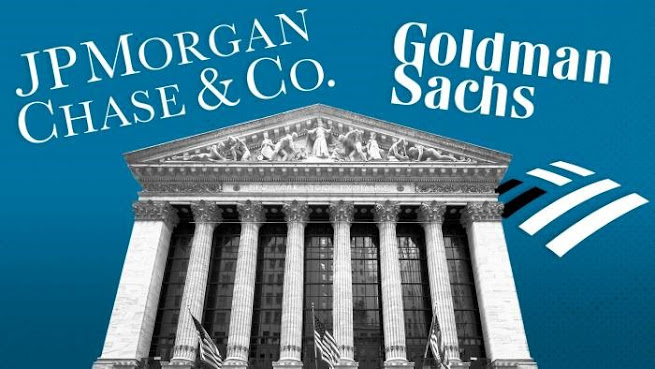Big US banks to post largest rise in loan losses since pandemic
Rising interest rates pile pressure on borrowers and commercial real estate losses mount
Joshua Franklin and Stephen Gandel in New York
 Analysts estimate that the six largest US banks have written off a collective $5bn tied to defaulted loans in the second quarter of this year © FT montage/Getty Images
Analysts estimate that the six largest US banks have written off a collective $5bn tied to defaulted loans in the second quarter of this year © FT montage/Getty ImagesThe largest US banks are this week set to report the biggest jump in loan losses since the onset of the coronavirus pandemic, as rising interest rates pile mounting pressure on borrowers across the economy.
The publication of second-quarter results is set to show that banks have benefited from higher interest rates to some degree, by boosting lending and investment income.
But after three years of relatively low defaults, in part fuelled by pandemic-era stimulus cash and other government assistance, lenders are also starting to see the negative effects of higher rates and inflation on borrowers.
The nation’s six largest banks — JPMorgan Chase, Bank of America, Citigroup, Wells Fargo, Goldman Sachs and Morgan Stanley — are predicted to have written off a collective $5bn tied to defaulted loans in the second quarter of this year, according to the average estimates of bank analysts, as compiled by Bloomberg.
The six lenders will set aside an estimated additional $7.6bn to cover loans that could go bad, analysts estimate.
Both figures are nearly double what they were in the same quarter a year ago.
However, they remain below the hits big banks took at the beginning of the pandemic when charge-offs and provisions peaked at $6bn and $35bn respectively.
Credit cards are the biggest source of pain for a number of the banks.
JPMorgan’s card loan charge-offs totalled $1.1bn in the quarter, analysts estimate, up from $600mn in the same period a year ago.
At BofA, credit card loans represent about a quarter of its charge-offs.
Commercial real estate (CRE) loans are also proving a drag on banks’ performance.
Property owners face reduced demand for office space as remote and hybrid work arrangements persist even though the pandemic has ended.
Wells Fargo, the biggest CRE lender among the nation’s largest banks, told investors this month that it added $1bn to its loan loss provisions to cover potential losses tied to office buildings and other poor-performing properties.
Investment banking is also likely to hit earnings. Revenues in the banks’ Wall Street and corporate advisory businesses are expected to fall again this quarter owing to a dearth of dealmaking activity that has dragged on for longer than many executives had anticipated.
Trading revenues, which soared in recent years amid volatile financial markets, are expected to slow.
Nonetheless, bank analysts say the benefits of increased interest rates are likely to outweigh the negatives for most of the big banks.
On average, analysts expect the six largest US banks to report that earnings per share rose 6 per cent year on year.
The biggest banks “have been a good place for investors to hide amid liquidity concerns for regional banks coupled with concerns regarding increased regulations”, wrote KBW bank analysts Christopher McGratty and David Konrad in a note to clients.
“That said, it remains a challenging environment for the universal banks.”
JPMorgan, which will be one of the first to report on Friday, is expected to announce the biggest percentage jump in loan losses from the same period a year ago.
Analysts predict the combined cost of loan charge-offs — losses marked as unrecoverable — and new provisions was $3.8bn in the second three months of the year.
That would be up 120 per cent from the $1.8bn in soured loans costs reported at the nation’s largest bank in the same quarter a year ago.
Combined loan losses at Wells Fargo and BofA are expected to have more than doubled in the quarter, with a 70 per cent jump at Goldman and 60 per cent increases at Morgan Stanley and Citi.
Kenneth Leon, a bank analyst at CFRA, predicts that BofA, Citi and JPMorgan will also add to their reserves that cover potential losses in commercial real estate this quarter.
“As lenders, banks can always do loan workouts with problem loans,” he wrote in a note to clients last month, “although certain individual office buildings may be challenging to remedy.”
JPMorgan, Citi and Wells Fargo report earnings on Friday followed by BofA and Morgan Stanley on July 18. Goldman reports on July 19.
The US banking sector withstood a crisis in its regional banking system this spring, but stress test results from the Federal Reserve showed the largest banks could suffer billions of dollars in losses and still have more capital than required by regulators.
Unlike many small and midsized banks that have been paying higher savings rates to retain customers, larger institutions are still offering relatively modest interest rates for savers, boosting their profit margins.
However, analysts anticipate that larger banks will eventually have to start offering better rates.
“In the third and fourth quarter the banks got a windfall to net interest income that was way up and above anything that anyone expected.
Now you’re going to give some of that back.
Nobody knows exactly how much but I don’t think it’ll be the majority,” said Chris Kotowski, research analyst at Oppenheimer.
0 comments:
Publicar un comentario